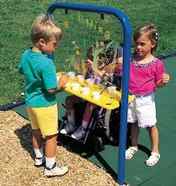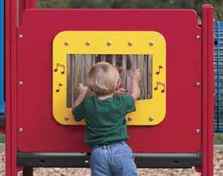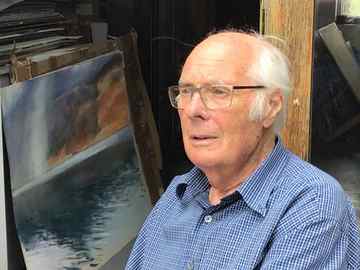During their second year, children creatively express their thoughts and feelings through symbolic play, also known as pretend play. Children will imitate a familiar role, such as pretending to be the mommy by feeding and rocking a baby doll. Children engage in movement activities that incorporate whole body movements to express emotion. For example, children will roll around on the floor if they are being playful, or squeeze caregivers when excited. Increased hand-eye coordination and attention help them engage in art activities such as scribbling and brush painting for longer periods of time.
Creative Expression
Children learn, develop critical skills, and have fun when provided the opportunity for creative, artistic expression. Painting, coloring, writing, making music, and making crafts are all creative activities. Creative expression helps children articulate their feelings and thoughts.
They think critically about their world and practice visual communication. Young children learn colors, shapes, and sounds during creative play. They begin to understand cause and effect. When children dance, they get physical exercise and develop coordination and balance.
Encouraging creative expression is easy in both indoor and outdoor playspaces. Include designated spaces for creativity, such as a music room, area, or panel. Outdoor playspaces can include areas for chalk drawing and art panels, while indoor playspaces can have an art room for drawing and painting. Even better invite artists to come and paint or sculpt with the children as part of your camp or programming activities.
Art

If you’ve ever tried scrubbing crayon marks off a freshly-painted wall, you know children like to express themselves artistically! While walls and floors might not be the best surfaces for their talents, its great to encourage children to freely explore making art. Provide space, time, and tools for art, and watch their creativity flourish! Also, ask children about their artistic projects and support their efforts with an open mind and positive responses.
In outdoor playspaces, art and nature go hand-in-hand. Invite children to help choose flowers and plants for gardens, noting the colors and shapes of what they select. Leave designated spaces for chalk drawing, and provide chalk if you have funds for it. Sand studios are great additions to outdoor playspaces. Make room for sheltered easels or install a clear plastic art panel.
Children can really let their artistic selves shine in indoor playspaces. Easels with paper, washable paints, and watercolors are a great starting point. But don’t stop there! Children can make art out of all sorts of materials. Scraps of colored paper, pictures from magazines, popsicle sticks, dried noodles, yarn, and cotton balls form fascinating collages. Let children reshape materials with safety scissors and glue. Play-dough and clay turn into amazing shapes in their little hands! You can even use recycled materials like toilet paper rolls, fabric samples, and paper dining products!
Music and dance

Two-year-old Ben runs to the kitchen and presses the button on the CD player, announces his favorite song to his mother, and grins as music fills the room. Several minutes later, he runs to the electronic piano in the living room and starts pounding keys. His mom does a silly dance for him and Ben laughs excitedly.
Music brings pleasure, calm, and satisfaction to children’s lives. Small babies respond to a soothing lullaby, toddlers have favorite songs, and preschoolers love to dance and sing. Older children idolize pop singers and plaster their room with posters.
Music is also beneficial for children. Listening and playing music, singing songs, and dancing help to develop important skills. The patterns and rhythms of music enhance spatial reasoning. Rhymes and repetitions sharpen memory and aid in the development of language and literacy. Children can also learn about culture and history through the exploration of music.
Make music a part of your playspace with some simple steps. Include a CD player or radio so children can choose background music for their play. Churches or universities might have pianos or other large instruments to donate. Xylophones, triangles, and conga drums are fun for children to play. Choreograph your child’s day with silly songs and funny dances.
Birth to 9 months
Children build the beginnings of creative expression through everyday interactions with their caregivers.
Indicators for children include:
- Actively explores sensory objects in the environment
- Participates in interactions with caregiver(s), e.g., observes, smiles, coos
- Demonstrates interest in sounds, songs, music, and colors
- Listens and moves to music
- Manipulates objects, e.g., turns, shakes, bangs
Strategies for interaction
- Provide the child with choices for exploration; follow his or her lead
- Interact in a meaningful manner with the child throughout the day
- Make music part of every day; sing songs with the child
- Provide toys and activities that encourage movement, e.g., a toy drum, a tunnel to crawl through
7 months to 18 months
Children increasingly engage with their caregiver(s) and show enjoyment in activities and interactions that focus on music, movement, building, and play.
Indicators for children include:
- Enjoys familiar songs and word rhymes
- Begins to use symbolic play while interacting, e.g., holds a play phone to ear and has a “conversation” with grandma
- Begins to stack large blocks with or without support
- Participates in music activities by performing some accompanying hand movements
- Engages in art activities such as coloring or finger painting
Strategies for interaction
- Sing songs with the child and model any accompanying gestures
- Provide the child with different options for creating artwork
- Demonstrate enjoyment of music and actively participate with the child as he or she sings
- Encourage the child to explore different materials while playing
16 months to 24 months
Children continue to show increasing ability as they engage with their caregiver(s) in music, movement, building, and play activities.
Indicators for children include:
- Imitates basic movements during an activity, e.g., places beanbag on head
- Engages in more intricate pretend play, e.g., uses a toy banana as a phone
- Enjoys using instruments while listening to music
- Builds by using different objects and materials, e.g., lines up cars, stacks small boxes
- Enjoys breaking down what he or she has built, e.g., knocking over a stack of blocks with his or her arm
- Creates artwork; focuses and enjoys the process rather than the final product
Strategies for interaction
- Provide props and instruments that the child can use during music and movement
- Engage in conversations about what the child is creating during art activities
- Display the child’s artwork where he or she can see it and show it off
- Provide play experiences both outdoors and indoors
Benefits of creativity and the arts
Research has shown that incorporating creativity and the arts into children’s lives can have a range of positive effects on their mental health and emotional wellbeing.
For example, studies have found that children who engage in artistic activities are more likely to have higher levels of self-esteem, increased resilience and improved social and emotional development.
Creativity and the arts can also provide a valuable coping mechanism for children who have experienced trauma or other difficult life experiences.
By providing a safe and supportive environment for creative expression, children can process difficult emotions and experiences in a healthy and constructive way.
Engaging in creative activities has been shown to have a positive impact on children’s cognitive development.
For example, learning to play an instrument has been linked to improved spatial reasoning skills, while drawing and painting can help to develop fine motor skills and hand-eye coordination.
In addition, participating in creative activities can improve children’s academic performance.
A study by the Arts Education Partnership found that students who participate in the arts are more likely to achieve higher grades, score higher on school tests and have better attendance in education.
The arts can provide a sense of cultural awareness and appreciation for diversity.
By exposing children to different art forms and cultural traditions, we can help to foster a greater sense of understanding and respect for others.
By allowing children to explore their interests and passions, we can help to nurture their sense of curiosity and wonder and provide opportunities for them to experience the joy of discovery and self-expression.
By incorporating the arts into children’s lives, we can help to support their overall wellbeing and provide them with valuable tools for personal growth and self-discovery.
As professionals supporting children’s growth and development, it’s important that we prioritise creativity and the arts as a fundamental part of children’s education and development.
Incorporating creativity and the arts into children’s lives
There are many ways to incorporate creativity and the arts into children’s lives.
For example, we can encourage children to participate in art classes, music lessons or other creative activities.
Schools can also incorporate creative expression into their lesson plans, providing opportunities for students to explore artistic expression and develop their creativity.
In addition to structured activities, we can also provide children with opportunities for unstructured play and exploration.
This might involve providing art supplies, musical instruments, or other creative tools and allowing children to explore their creative side in their own way.
Another way to incorporate creativity and the arts into children’s lives is to expose them to different forms of art and cultural experiences.
This could involve taking them to museums, concerts, drama performances or simply exploring different types of music, art and literature.
It’s important to remember that creativity and the arts don’t have to be expensive or time-consuming.
Simple activities like drawing or painting, singing songs, or playing an instrument can be a great way to incorporate creativity into children’s daily lives.
The bottom line is it’s important to create a safe and supportive environment for children’s creative expression.
This means providing positive feedback and encouragement and avoiding overly critical or judgmental attitudes towards children’s creative efforts.
In conclusion, incorporating creativity and the arts into children’s lives can have a profound impact on their overall wellbeing and development.
By providing opportunities for creative expression, we can help to nurture children’s emotional, social and cognitive development, while also providing them with a sense of joy, fulfilment and cultural awareness.
We have a responsibility to prioritise creativity and the arts as essential components of children’s education and growth.
Final thoughts
Through incorporating creative expression and opportunities into children’s lives, we can help to foster a sense of joy, fulfilment, identity and positive self-esteem, while also promoting wider positive social and emotional development.
Give yourself permission to play too!
Whether it’s through structured activities or unstructured play, there are so many ways to encourage, enable and empower children to explore their creative side to unlock new possibilities.
It’s not all about the ‘structured interventions’.
Every interaction has the potential to become an intervention, if you grab hold of it, value it and take the opportunity to make a difference!
The most important thing to remember is to take action. All the information in the world won’t make a difference unless you put it into practice!
I really appreciate you investing the time to read my article today, especially knowing your busy schedules and your ongoing to-do lists!
I really do hope that these articles give you the practical tools to implement and make a difference to the lives of the children and families you support.
We are all on a journey of learning, taking the latest research and best practice into account and developing ourselves and our practice.
If you find the newsletter or articles useful, please consider sharing them with your colleagues and network who benefit in the same way you do.
You can promote the message by giving a like to show support, a comment to share your thoughts, a share to show your network or you can subscribe to receive weekly articles all focused on creating better outcomes for our children.
Stay safe and look after yourself.
As always, please feel free to reach out to me with any questions or comments, all feedback is warmly welcomed.



